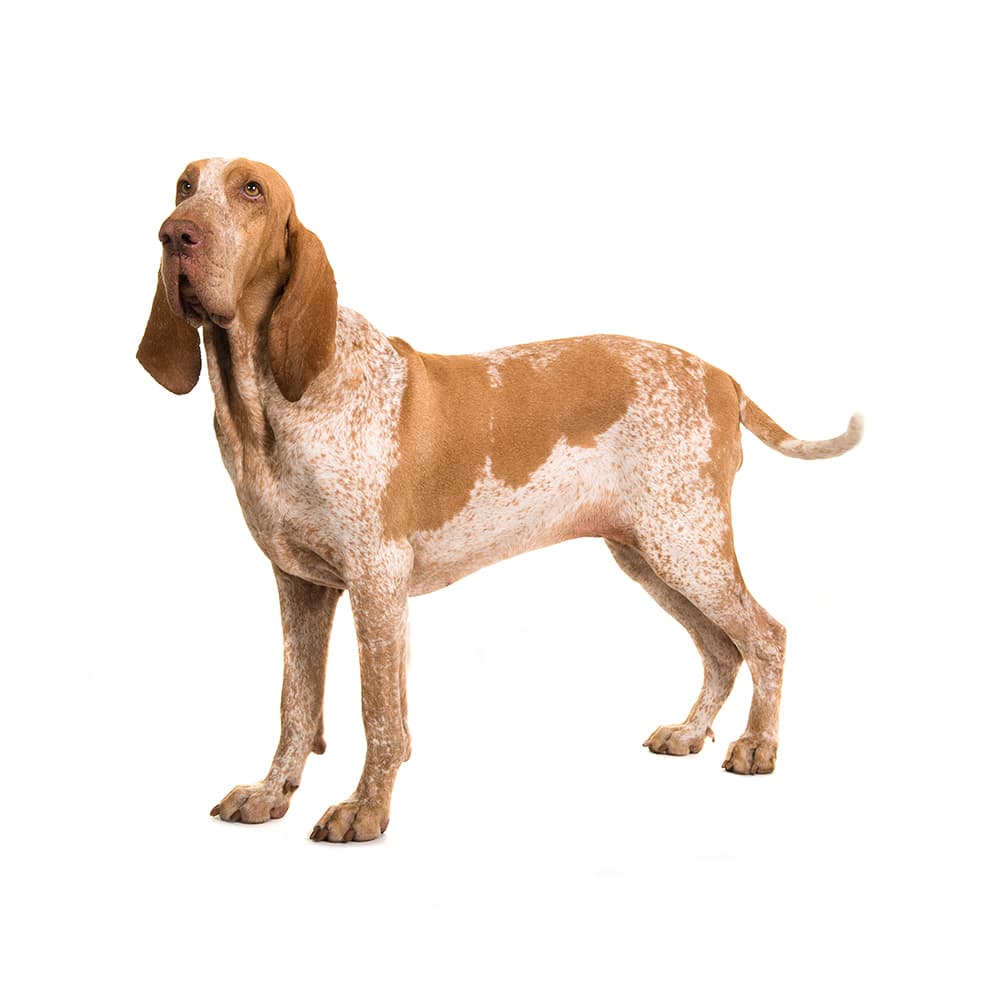Discover your dog's connection to this breed and 200+ others


Discover your dog's connection to this breed and 200+ others



The Bracco Italiano, also known as the Italian Pointer, is a breed of dog developed in Italy as a versatile gun dog. The breed has a rich history that dates back to the 4th or 5th century B.C. It is believed to have descended from dogs used by the ancient Egyptians, who traded them with the Phoenicians. From there, the breed made its way to the Mediterranean, where it was further developed in Italy. It's one of the oldest pointing breeds known, and its history can be traced back to Renaissance Italy, where it was bred to be an excellent hunting dog, used for pointing and retrieving game. Famous Italian nobles and even Leonardo Da Vinci are said to have kept and praised the breed.
The Bracco Italiano is a generally healthy breed, but may be prone to ear infections, so ears should be kept clean and dry. Like many other breeds, Braccos can suffer from hip and elbow dysplasia, degenerative myelopathy, renal disorders such as hyperuricosuria or the more rare disorder renal amyloidosis. They can also be prone to eye conditions including progressive rod-cone degeneration, entropion, ectropion, and cataracts. Before one year of age, Bracco puppies shouldn’t exercise on concrete or similar hard surfaces, as they can be prone to orthopedic stress during fast growth spurts. As for all breeds, genetic screening is recommended to assist veterinarians with diagnosis and proactive care, as well as help breeders identify affected and carrier dogs.
The Bracco Italiano is known for its gentle, friendly, and affable personality. They are known to be extremely devoted to their family and are typically good with children and other animals. They are intelligent dogs, eager to please, which can make training easier, although their training should always be conducted with a gentle hand and positive reinforcement.
Braccos are active and energetic dogs, needing plenty of exercises. They are excellent hunters but also enjoy activities such as obedience, agility, and tracking exercises. They enjoy being included in all family outings and activities and aren't a breed that enjoys being left alone for long periods.
Despite their hunting background, Braccos are known to be calm and balanced indoors, making them excellent house dogs, provided they get plenty of daily exercise. They are very sociable dogs, who love being with their family, and they are not suitable for an environment where they are left alone for long periods of time.
A canine genetic lineage is a group of individuals or entire breeds that descended from common ancestors predating modern breed formation. Often these lineages are associated with a ‘type’ of dog with a unique historical working role and associated behaviors (e.g., herding, scent hunting, etc.).
The Pointer-Spaniel lineage encompasses both pointer and spaniel breeds. They were both bred for their specialized hunting abilities in Europe. Pointers locate game and freeze in a stance, called “pointing”, to indicate to their hunter that birds are close by. Spaniels were bred to find game in underbrush and retrieve it. Both pointer and spaniel breeds were bred to enhance their strong senses, trainability, and endurance as these are advantageous in a hunting partner. Spaniels and pointers are known for their strong work ethic, ability to work closely with humans and agility. These dogs’ ability to work closely with their hunters makes them an asset during a hunt because they follow direction well and know how their hunters want them to proceed.
Example breeds with ancestry from this lineage include English Cocker Spaniel, Irish Red Setter, and German Shorthaired Pointer.
This ancient breed was beloved by the Gonzaga and Medici families, who bred them and made them available for nobles and royal families of Italy.
During the 1800s and early 1900s, the Bracco Italiano faced a decline due to poor breeding practices. However, in the mid-20th century, thanks to a few dedicated breeders who worked to rejuvenate the breed, the Bracco Italiano began to flourish again in Italy.
https://vgl.ucdavis.edu/breed/bracco-italiano?page=1 https://www.akc.org/dog-breeds/bracco-italiano/ https://www.thekennelclub.org.uk/search/breeds-a-to-z/breeds/gundog/bracco-italiano/ https://ofa.org/chic-programs/browse-by-breed/?breed=BRI
https://www.fci.be/Nomenclature/Standards/202g07-en.pdf
Recommended by top vets with decades of experience
21 breeds
64 genetic health markers
50 genetic trait markers
